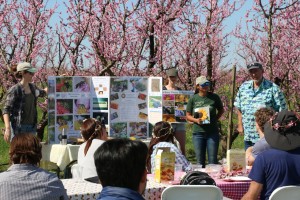
Gordon Frankie and his students sharing info about their work at Frog Hollow Farm at the 2017 Spring Stroll.
Spring is synonymous with blooming flowers and where there are blooming flowers there are bees! And while most people think of European honey bees, we work hard to make the farm a hospitable place for all sorts of bees, especially those native for California who are an important part of pollination in our orchard.
If you have ever come out to visit us you haveseen how Frog Hollow Farm is the odd-farm-out when it comes to the surrounding farmland. Many of our neighbors practice some form of conventional monoculture, meaning they grow one crop in big fields using conventional (non-organic) methods to fertilize and manage pests. As a result, most of these farms have barren ground around their crops with no weeds or wildflowers. Frog Hollow Farm, on the other hand, has massive amounts of cover crops growing on the ground between our trees and native plants scattered on the edges of our orchards. Conventional farms might see these other plants as competition for their crops but we know that they can serve us, both as a mulch to help keep precious water in the ground and to help provide food and shelter to the many bees that help pollinate our fruit trees each spring.
To help us support native bee populations we are lucky to have the help Gordon Frankie, from the Department of Environmental Science, Policy, & Management at Cal. Farmer Al was an early adopter as one of the first farmers working with the Urban Bee Lab to increase native bee habitat for pollination. Since 2010 Gordon has helped us by selecting varieties of plants to use as cover crop in our orchards that serve as food sources for a wide variety of native bees as well as helping to prevent erosion and water loss. What started as an informal project has become official with the support of the Cal Berkeley and National Resources Conservation Service (formerly known as the Soil Conservation Service). NRCS, a part of the Department of Agriculture, provides farmers and landowners with financial and technical assistance to voluntarily put conservation “on the ground” to help the environment and agriculture.
With Gordon’s expertise, funding for seeds from NRCS and our staff’s hard work we have planted wildflowers like Phacelia, California Poppy, Berseen Clover and Blue Thimble flower. We also have many orchard edges lined with perennial plants like vitex, ceanothus, and sage that provide bee forage and also help protect our crops from the wind. This time of year, the brilliant flowers of these plants attract an incredible number of native bees but they also feed and shelter moths, butterflies and birds, too! We have experimented with other plant like Catnip Mint, which is great for pollinators but, unfortunately, isn’t hearty enough for our climate in Brentwood. Water has been and continues to be the biggest challenge, as you all know, is hard in our increasingly hot and dry climate. While we struggle with providing enough water for bee-friendly plants, we still can see this hard work is paying off because Gordon and his team have seen over 50 different species of bees at Frog Hollow Farm! For more info visit helpabee.org

 Follow
Follow
